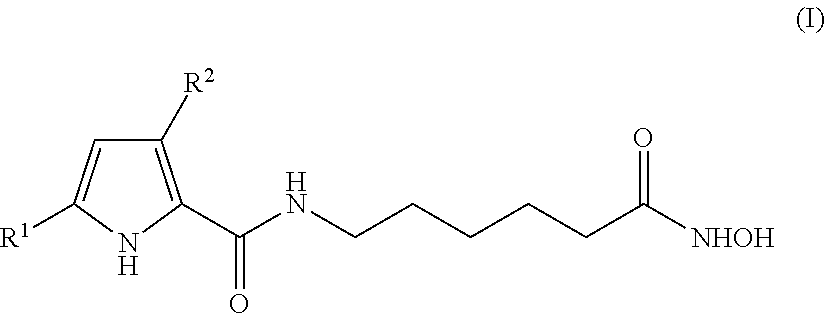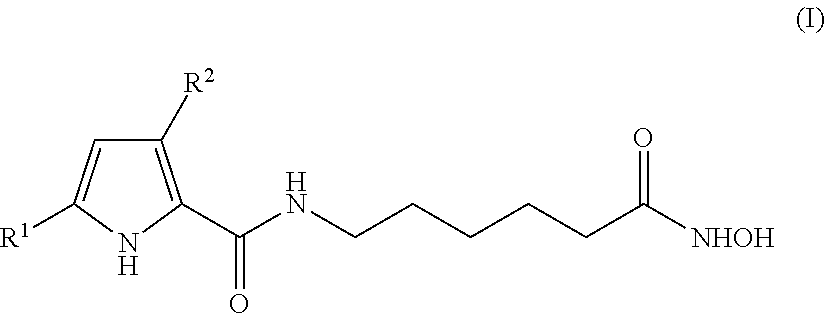Hydroxyphenyl pyrrole compounds containing an hydroxamic acid as HDAC inhibitors and medicinal applications thereof
- Summary
- Abstract
- Description
- Claims
- Application Information
AI Technical Summary
Benefits of technology
Problems solved by technology
Method used
Image
Examples
example 1
Preparation of N-(6-(hydroxyamino)-6-oxohexyl)-3-(4-hydroxyphenyl)-5-phenyl-1H-pyrrole-2-carboxamide, with the Following Structural Formula
[0135]
This material was prepared using one of the methods described herein, yielding the title compound.
Method A
3-(4-Hydroxyphenyl)-5-phenyl-1H-pyrrole-2-carboxylic acid
[0136]
[0137]A solution of (2E)-3-(4-hydroxyphenyl)-1-phenylprop-2-en-1-one (4.7 g, 20.98 mmol) and ethyl nitroacetate (2.32 ml, 20.98 mmol) in triethylamine (8.77 ml, 62.94 mmol) was stirred at 75° C. for 4 h. Ethyl acetate (500 ml) was added and the solution obtained was washed with HCl 1N (4×250 ml), dried over Na2SO4 and evaporated under reduced pressure, to obtain 6.94 g of ethyl 3-(4-hydroxyphenyl)-2-nitro-5-oxo-5-phenyl-pentanoate.
[0138]To this material a 0.5 M solution of sodium methoxide in methanol (58.2 ml) was added and the mixture was stirred for 4 h. Then it was poured over a mixture of H2SO4 (12 ml) and MeOH (59 ml) at −20° C. The resulting mixture was stirred at −20...
example 2
Preparation of N-(6-(hydroxyamino)-6-oxohexyl)-5-(4-hydroxyphenyl)-3-phenyl-1H-pyrrole-2-carboxamide, with the Following Structural Formula
[0162]
[0163]This material was prepared using a method substantially similar to that of Example 1, Method A, yielding the title compound N-(6-(hydroxyamino)-6-oxohexyl)-5-(4-hydroxyphenyl)-3-phenyl-1H-pyrrole-2-carboxamide: Yield 85%; m.p. 224-225° C.; IR 3408, 3258, 1679, 1638, 1524, 1286 cm−1; 1H-NMR (300 MHz, δ ppm, DMSO-d6) 11.29 (s, 1H), 10.31 (s, 1H), 9.47 (s, 1H), 8.61 (s, 1H), 7.60 (d, J=8.7 Hz, 2H), 7.49 (d, J=7.0 Hz, 2H), 7.35 (t, J=7.4 Hz, 2H), 7.27 (dt, J=4.6 Hz, J′=1.8 Hz, 1H), 7.21 (s, 1H), 6.79 (d, J=8.7 Hz, 2H), 6.47 (d, J=2.7 Hz, 1H), 3.15 (dd, J=12.7 Hz, J′=6.7 Hz, 2H), 1.93 (t, J=7.3 Hz, 2H), 1.53−1.36 (m, 4H), 1.27−1.20 (m, 2H); 13C-NMR (126 MHz, δ ppm, DMSO-d6) 169.7, 161.6, 157.2, 136.5, 134.0, 129.4, 128.5, 128.3, 126.8, 126.7, 123.4, 122.8, 116.0, 107.4, 39.1, 32.8, 29.3, 26.6, 25.4.
example 3
Preparation of N-(5-(hydroxycarbamoyl)pentyl)-3-(4-hydroxyphenyl)-5-(3-thienyl)-1H-pyrrole-2-carboxamide, with the Following Structural Formula
[0164]
[0165]This compound was prepared using a method substantially similar to that of Example 1, Method A: Yield 93%; m.p. 100-102° C.; IR 3396, 3238, 1653, 1621, 1547, 1272 cm−1; 1H-NMR (500 MHz, δ ppm, DMSO-d6) 11.53 (s, 1H), 7.89 (s, 1H), 7.55 (d, J=1.9 Hz, 2H), 7.27 (d, J=8.5 Hz, 2H), 6.83 (tb, J=4.9 Hz, 1H), 6.79 (d, J=8.5 Hz, 2H), 6.47 (s, 1H), 3.14 (dd, J=12.6 Hz, J′=6.4 Hz, 2H), 1.94 (t, J=7.3 Hz, 2H), 1.50−1.44 (m, 2H), 1.41−1.34 (m, 2H), 1.21−1-15 (m, 2H); 13C-NMR (126 MHz, δ ppm, DMSO-d6) 169.0, 161.0, 156.3, 133.4, 129.9, 129.3, 127.1, 126.3, 126.1, 125.9, 121.9, 118.7, 115.1, 108.3, 38.4, 32.2, 28.7, 26.0, 24.8.
PUM
| Property | Measurement | Unit |
|---|---|---|
| Temperature | aaaaa | aaaaa |
| Temperature | aaaaa | aaaaa |
Abstract
Description
Claims
Application Information
 Login to View More
Login to View More - Generate Ideas
- Intellectual Property
- Life Sciences
- Materials
- Tech Scout
- Unparalleled Data Quality
- Higher Quality Content
- 60% Fewer Hallucinations
Browse by: Latest US Patents, China's latest patents, Technical Efficacy Thesaurus, Application Domain, Technology Topic, Popular Technical Reports.
© 2025 PatSnap. All rights reserved.Legal|Privacy policy|Modern Slavery Act Transparency Statement|Sitemap|About US| Contact US: help@patsnap.com



